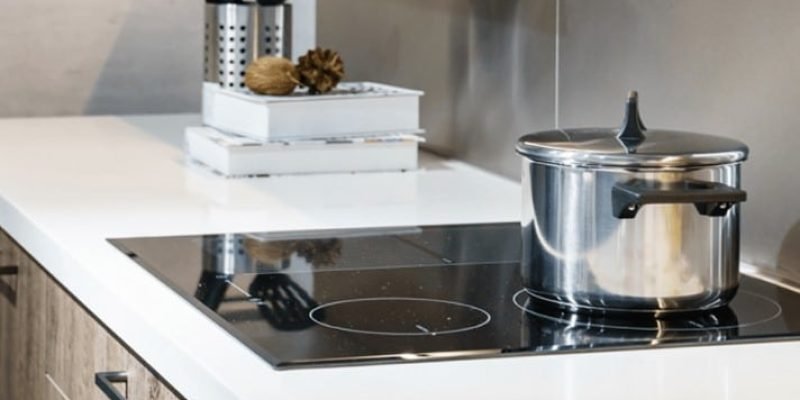As humans, we’ve come a long way.
Admittedly, our ancestors had it rough. Saber tooth tigers and unnamed diseases aside, these guys faced another problem: cooking. First, they had to rub two sticks together until they had some fire going. Then, they grabbed anything handy, like animal hides, and used them to cook.
But thank heavens, we don’t have to do that anymore. Today, you can simply walk into the kitchen, fire up your stovetop, and start cooking. Pretty convenient, right? But how equipped is your kitchen? What kind of cooktop are you using or planning to buy? Are you confused with the many options available out there?
Don’t worry…..
We’ve listed several cooktops and stovetops that any homeowner should consider. And to make it super easy for you, we have provided pros and cons for each, and a few recommendations that you’ll love. Read on!
10 Most Common Types of Stovetops and Cooktops
Whether you love cooking with gas or would rather go electric, we’ll help you discover the best cooktop to spark your culinary creativity. Your kitchen is waiting to become a chef’s studio – so let’s get cooking on finding your perfect stovetop match!
Here’s a comprehensive overview of the 10 most common cooktops and stoves:
1. Electric Cooktops

Despite many people ranking gas stoves as the most popular appliances today, electric cooktops take the cake. That is because 68% of US households have electric stoves.
There are two popular types of electric cooktops: electric coil and glass top stoves. Most households prefer using electric cookers because they are more energy-efficient than gas cookers. But, as you’ll discover shortly, there’s a catch.
Pros
- Electric stovetops are more efficient than gas cookers. So, if you want to cut energy consumption, go with the former.
- Compared to gas stoves, electric cooktops are much safer. That is because these appliances don’t have open flames and are not associated with gas leaks.
- According to studies, homes with electric stovetops enjoy better air quality and fewer percentages of pollutants like carbon monoxide and nitrogen dioxide.
Cons
- Electricity is significantly pricier than gas. As a result, despite electric cooktops being more efficient, they often lead to higher energy bills.
- As the name implies, electric cookers rely on electricity. So, during outages, the appliances are useless.
2. Gas Cooktops
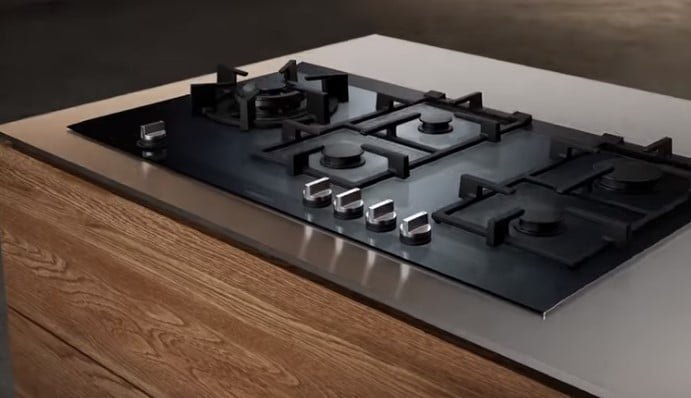
Gas stoves are the second-most popular cooking appliances today. According to statistics, approximately 47.1 million US households (38%) have at least one gas stove. Additionally, 96% of professional cooks prefer using gas, which has contributed immensely to the popularity of these appliances.
Why are gas cooktops so popular, you wonder? The main reason is that gas is cheaper than electricity. If you switch from an electric cooker to a gas stovetop today, your utility bill can drop by up to 30%.
Pros
- As I’ve mentioned, using a gas cooktop can reduce your energy bills by a significant margin.
- Since the flame can be adjusted instantly, gas cooktops heat up faster than their electric counterparts. They also cool down quickly.
- Gas stoves are compatible with virtually all types of cookware. That differs from alternatives like induction cooktops, which demand flat-bottomed pots and pans made of specific materials.
Cons
- Experts associate gas stovetops with numerous harmful pollutants, including nitrogen dioxide and carbon monoxide. These often cause respiratory problems, among other health issues.
- Gas cooktops are harder to clean since they have components like raised pan supports and heating elements. These often trap food residue and grime, which can accumulate quickly.
3. Induction Cooktops
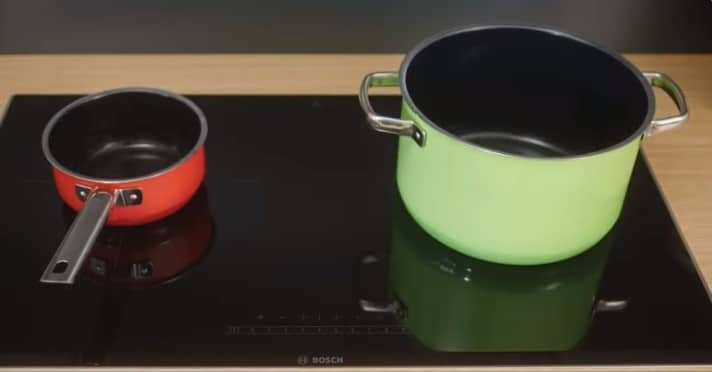
Induction stovetops heat cookware through induction. These appliances are designed to pass an electric current through the installed heating element, creating a magnetic field that makes cooking possible.
Less than 1% of US households have induction cooktops, meaning these appliances are significantly less popular than traditional gas and electric stovetops. That said, they are gaining ground remarkably fast. 70% of respondents from a recent survey said they would consider getting induction cooking appliances next time they shop for a cooktop or a range
Pros
- Induction cookers are more energy efficient than their counterparts. For instance, according to the US Department of Energy, these appliances are up to 3x more efficient than gas stovetops.
- Since induction cooktops only heat the cookware, they are less susceptible to burned-on gunk. That makes them easier to clean.
- Induction cooking is flameless. As such, it’s unlikely to cause a fire or severe burns. But you shouldn’t touch your cooktop’s cooking area after using it because cookware can transfer heat to it.
- Most quality induction cookers have precise temperature control features, which makes them ideal for precise cooking.
Cons
- To use these appliances seamlessly, you must have induction-ready cookware. Induction cooktops require pots and pans made from a magnetic material like stainless steel.
- Induction hobs are pricier than other conventional appliances.
4. Downdraft Cooktops
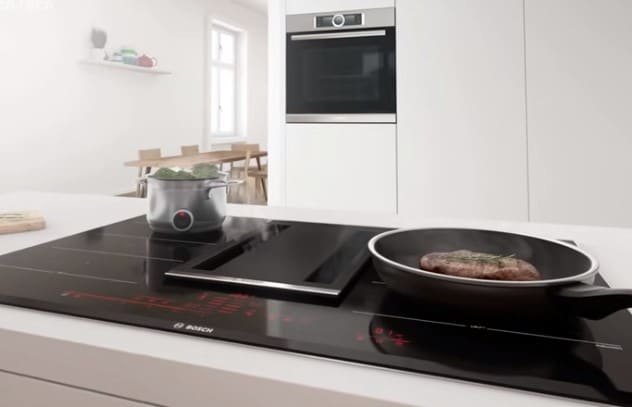
A downdraft cooktop is simply an appliance whose cooking surface comes with a ventilation system, which captures and eliminates odors, steam, smoke, and more. Downdraft cooktops are ideal for kitchens that don’t have overhead vents.
Pros
- With a downdraft cooktop, you don’t have to install an overhead ventilation system, which saves you from spending hundreds of dollars.
- A downdraft cooker gives you more overhead space, which you can use however you wish, like installing more cabinets.
- Most of these cooktops have a sleek, contemporary design, making them suitable for modern kitchens.
Cons
- A downdraft cooker uses an exhaust pipe to dispose of smoke, steam, and odors. That means you must invest in a suitable piping and venting system after purchasing this appliance.
5. Dual-fuel Stoves
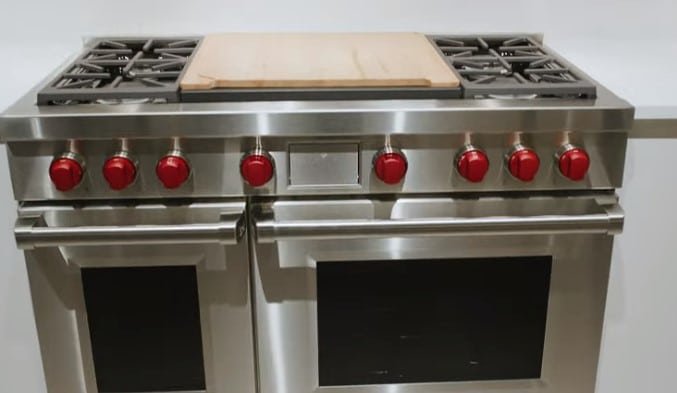
A dual-fuel stove comes with a gas stovetop and an electric oven. If you cherish the thrill of cooking with an open flame on your cooktop but prefer using the dry, even heat that makes electric ovens so popular, consider buying this appliance.
Pros
- Since dual-fuel cookers have gas stovetops that produce open flames, they can preheat cookware quickly.
- In areas where electricity is pricier than gas, the gas cooktops in dual-fuel stoves help owners save a pretty penny.
- Dual-fuel cookers are often exquisitely designed. If your kitchen needs a little vamping, grab one of these appliances.
- The electric oven that comes with these appliances makes them perfect for baking delicious treats.
Cons
- Dual fuel stoves are pricier than most conventional models.
6. Pro-style Commercial Ranges
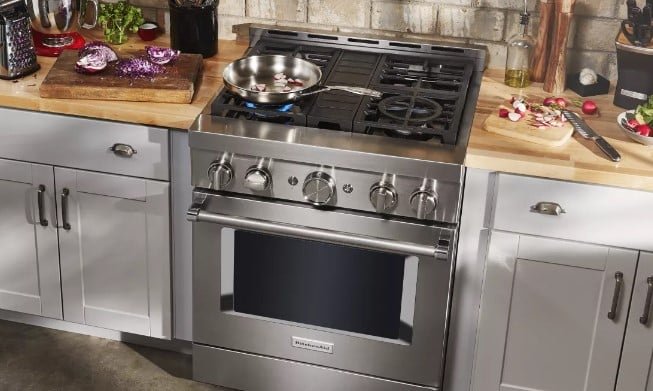
If you like turning every meal into an inspiration, get a pro-style or commercial-style commercial range. This appliance is specially designed for a restaurant-inspired cooking experience. A good pro-style commercial cooker comes with premium features you won’t find in most standard cooktops, such as built-in grills and high-BTU burners.
Pros
- Commercial-style cookers have powerful burners that can deliver high heat. Most of these appliances boast burners with an output of 15,000-25,000 BTUs.
- Most of these appliances are extra-large. Their phenomenal space lets you do multiple things simultaneously, like baking in the oven and sauteing with one cooking zone while searing steak with another.
- The powerful cookers have a haute, next-gen look. They are ideal for turning an ordinary kitchen into a marvel that’ll impress anyone who beholds it.
Cons
- The high-heat burners that professional-style stoves use can turn your kitchen space into a hellhole filled with excessive heat and smoke.
- These appliances come with high price tags.
7. Freestanding Cookers
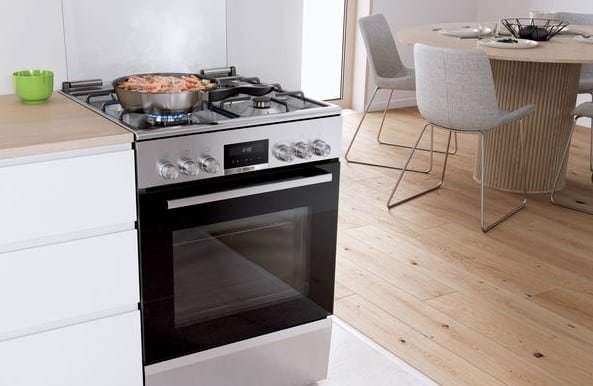
A freestanding stove gives you uncapped freedom to arrange your kitchen area as you wish. You can install this appliance between cabinets whenever you’re going for a built-in look or set apart, unattached from cabinets or walls.
Pros
- Top-of-the-range freestanding cookers come with almost everything a cuisine connoisseur might need, including multiple burners, a rotisserie, and an oven.
- Since it doesn’t have to be attached to anything, a freestanding stove is easy to relocate with or move around the kitchen,
- Installing a freestanding cooker is as easy as planting it on an available kitchen slot—no need to hire professional installers.
- These cookers are easy to clean and maintain.
Cons
- If you buy a freestanding stove and the stovetop or oven breaks down, replacing it can be a nightmare. In fact, you have to call in a professional.
8. Cookstoves
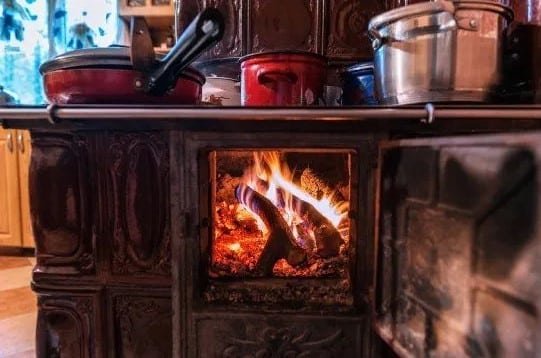
Cookstoves are traditional appliances that rely on solid fuels like coal, wood, and agricultural waste. They have been around for centuries and are used primarily by people living in rural areas. But, since these appliances don’t rely on gas lines or electricity, they are a splendid option for outdoor cooking. If you often go camping, hiking, etc., a cookstove should be your best friend.
Pros
- Since these appliances don’t rely on gas or electricity, they often remain untouched by broken gas lines and power outages.
- Several clean cookstoves that don’t use dirty fuels like wood and coal are available today. On the contrary, they run on better alternatives like solar energy and wood pellets.
- Cookstoves are significantly cheaper than modern alternatives like smooth electric cooktops and induction hobs.
Cons
- Traditional cookstoves produce lots of smoke, which makes using them indoors a terrible idea.
- Wood-burning cookstoves contribute to deforestation and adverse climate change.
9. Modular Cooktops
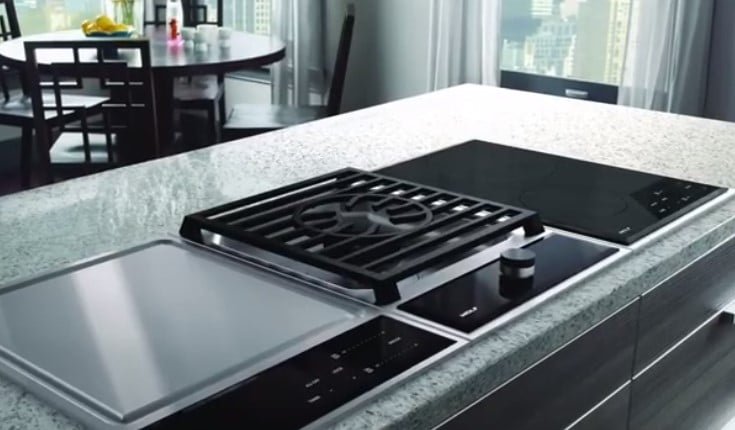
Humans have different needs, tastes, and preferences. To account for that, appliance manufacturers are now selling modular cooktops. With a modular cooktop, you get to specify what you want.
For instance, you can get a modular cooker with individual gas and electric burners and switch from one to another whenever necessary. Or, you can install a deep fryer right in the middle of your stove. The only limit here is your imagination.
Pros
- A modular cooktop comes with uncapped design flexibility. With it, you can optimize kitchen space and create an ambiance that matches how you live, prepare meals, and entertain.
- With this appliance, you can add any elements you deem necessary, like a fryer, grill, girdle, steamer, etc.
- Modern modular stoves have next-level features that make them incredibly easy to use, like touch display and voice command.
Cons
- Modular stoves are complex appliances. As such, they are often more expensive than conventional alternatives like gas and electric cooktops.
10. Tabletop Griddles
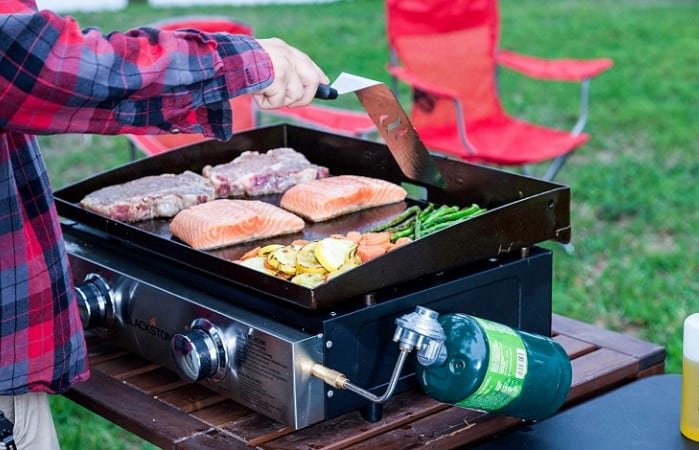
A tabletop griddle is a compact, lightweight appliance you can place on your countertop or a small table while cooking. And when you’re done, you can stash it in a kitchen cabinet, saving much-needed space. You can use a gas or electric tabletop griddle to prepare anything, from pancakes and waffles to grilled T-bone steak and stir-fried vegetables.
Pros
- A tabletop griddle doesn’t consume a lot of space. Plus, since it’s lightweight, handling it is a lot easier.
- Despite being small, tabletop griddles can cook almost anything, including dishes that demand incredibly high heat. Most quality griddles can go beyond 450°F.
- Like other modern appliances, tabletop griddles don’t produce excess smoke.
Cons
- Most tabletop griddle owners say their appliances are tough to clean.
- Top-shelf tabletop griddles cost a pretty penny.
Which Cooktop Should You Get for Your Kitchen? Factors to Consider
As you can see, so many cooktops are available today. Whatever we’ve discussed here is nothing but broad categories. If we break everything down further into brands and models, you’ll be shell-shocked. So, how do you pick an excellent appliance from all the products sold out here? Let the following guide your hand:
- Your kitchen layout and available space: If you have a small, tight-fitting kitchen with many other appliances, consider buying a compact-sized cooktop. But if space isn’t a problem, go wild.
- Brand reputation: Prioritize purchasing appliances from reputable brands exclusively. Before buying anything from any company, check their online reputation.
- Cooktop specs and features: Stovetops are different. For instance, some have one cooking zone, while others have multiple burners. While choosing an appliance, read through all the features and specifications.
- Your budget: Not everyone has an unlimited supply of money. If, at the moment, you are working with a limited budget, try to find an affordable cooktop. But if you have lots of cash and aren’t afraid of burning some, go for classy cooktops with the best features.
Key Takeaways
If you plan to buy a cooktop, we’ve armed you with the information you need to make an informed decision. Based on what we’ve discussed, you can weigh the pros and cons of each available option and isolate a product that’ll serve you well for many years.
Before hunting for an excellent appliance, do you remember the factors we told you always to consider? They include your budget, kitchen layout, and appliance features. Never forget them. They will guide you and save you from buying an appliance that won’t do you any good.
May your next cooktop-related shopping extravaganza turn into a roaring success!
Common Questions
What cooktop is the most affordable?
Electric coil cooktops are generally the most budget-friendly option. Smoothtop electric ranges are moderately priced. Gas and induction typically cost more upfront.
Which is better for even heating – gas, electric, or induction?
Induction cooktops provide the most even, consistent heating. Electric smoothtops are next best, followed by gas which can have hotspots.
